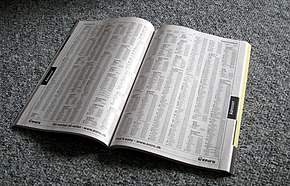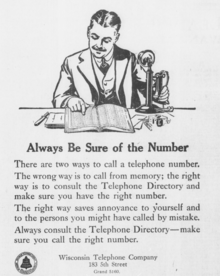A telephone directory, commonly called a telephone book, telephone address book, phonebook, or the white and yellow pages, is a listing of telephone subscribers in a geographical area or subscribers to services provided by the organization that publishes the directory. Its purpose is to allow the telephone number of a subscriber identified by name and address to be found.

The advent of the Internet, search engines, and smartphones in the 21st century greatly reduced the need for a paper phone book.[1][2] Some communities, such as Seattle and San Francisco, sought to ban their unsolicited distribution as wasteful, unwanted and harmful to the environment.[3][4]
The slogan "Let Your Fingers Do the Walking" refers to use of phone books.[1]

Content
editSubscriber names are generally listed in alphabetical order, together with their postal or street address and telephone number. In principle every subscriber in the geographical coverage area is listed, but subscribers may request the exclusion of their number from the directory, often for a fee; their number is then said to be "unlisted" (US and Canada), "ex-directory" (British English), or "private" (Australia and New Zealand).[5]
A telephone directory may also provide instructions: how to use the telephone service, how to dial a particular number, be it local or international, what numbers to access important and emergency services, utilities, hospitals, doctors, and organizations who can provide support in times of crisis. It may also have civil defense, emergency management, or first aid information. There may be transit maps, postal code/zip code guides, international dialing codes or stadium seating charts, as well as advertising.
In the US, under current rules and practices, mobile phone and voice over IP listings are not included in telephone directories. Efforts to create cellular directories have met stiff opposition from several fronts, including those who seek to avoid telemarketers.[citation needed]
Types
editA telephone directory and its content may be known by the colour of the paper it is printed on.
- White pages generally indicates personal or alphabetic listings.
- Yellow pages, golden pages, A2Z, or classified directory is usually a "business directory", where businesses are listed alphabetically within each of many classifications (e.g., "lawyers"), almost always with paid advertising.
- Grey pages, sometimes called a "reverse telephone directory", allowing subscriber details to be found for a given number. Not available in all jurisdictions. (These listings are often published separately, in a city directory, or under another name, for a price, and made available to commercial and government agencies.)
Other colors may have other meanings; for example, information on government agencies is often printed on blue pages or green pages.[citation needed]
Publication
editTelephone directories can be published in hard copy or in electronic form. In the latter case, the directory can be on physical media such as CD-ROM,[6] or using an online service through proprietary terminals or over the Internet.[7][8]
In many countries, directories are both published in book form and also available over the Internet. Printed directories were usually supplied free of charge.
CD ROM
editSelectphone (ProCD) Inc.)[9] and PhoneDisc (Digital Directory Assistance Inc) were among the earliest such products. These were not a matter of a single click: PhoneDisc, depending on the mix of Residential, Business or both, involved up to eight CD-ROMs.[7] SelectPhone is fewer CD-ROMs: five.[9]
Both provide a reverse lookup feature (by phone number or by address), albeit involving up to five CD-ROMs.[8][9]
Internet
editThe combination of phone number lookups, along with Internet access, was offered by some service providers; VoIP (Voice over IP) was an additional feature.[10][11]
History
editTelephone directories are a type of city directory. Books listing the inhabitants of an entire city were widely published starting in the 18th century, before the invention of the telephone.
The first telephone directory, consisting of a single piece of cardboard, was issued on 21 February 1878; it listed 50 individuals, businesses, and other offices in New Haven, Connecticut, that had telephones.[12] The directory was not alphabetized and no numbers were included with the people listed in it.[13] In 1879, Dr. Moses Greeley Parker suggested the format of the telephone directory be changed so that subscribers appeared in alphabetical order and each telephone be identified with a number. Parker came to this idea out of fear that Lowell, Massachusetts's four operators would contract measles and be unable to connect telephone subscribers to one another.[13]
The first British telephone directory was published on 15 January 1880 by The Telephone Company. It contained 248 names and addresses of individuals and businesses in London; telephone numbers were not used at the time as subscribers were asked for by name at the exchange.[14] The directory is preserved as part of the British phone book collection by BT Archives.
The Reuben H. Donnelly company asserts[15] that it published the first classified directory, or yellow pages, for Chicago, Illinois, in 1886.
In 1938, AT&T commissioned the creation of a new typeface, known as Bell Gothic, the purpose of which was to be readable at very small font sizes when printed on newsprint where small imperfections were common.[citation needed]
In 1981, France became the first country to have an electronic directory on a system called Minitel.[16] The directory is called "11" after its telephone access number.
In 1991, the U.S. Supreme Court ruled (in Feist v. Rural) that telephone companies do not have a copyright on telephone listings, because copyright protects creativity and not the mere labor of collecting existing information.[17]
In late July 1995 Kapitol launched the Infobel.be website. [18] [19] Infobel was then the first telephone directory website launched on the then-nascent Internet. In 1996, in the US the first telephone directories went online. Yellowpages.com and Whitepages.com both saw their start in April.[20] In 1999, the first online telephone directories and people-finding sites such as LookupUK.com went online in the UK. In 2003, more advanced UK searching including Electoral Roll became available on LocateFirst.com.
With online directories, and with many people giving up landlines for cell phones whose numbers are not listed in telephone directories, printed directories are no longer as necessary as they once were. Regulators no longer required that residential listings be printed, starting with New York in 2010. Yellow pages continued to be printed because some advertisers still reached consumers that way.[21]
In the 21st century, printed telephone directories are increasingly criticized as waste. In 2012, after some North American cities passed laws banning the distribution of telephone books, an industry group sued and obtained a court ruling permitting the distribution to continue.[3] In 2010, manufacture and distribution of telephone directories produced over 1,400,000 metric tons of greenhouse gases and consumed over 600,000 tons of paper annually.[22]
Reverse directories
editA reverse telephone directory is sorted by phone number, so the name and address of a subscriber is looked up by phone number.[9]
See also
editReferences
edit- ^ a b "Phone books used as truck fuel in Fla". New York Post. 15 June 1992. p. 9.
- ^ By 1992 one phone company, which had collected 58,000 tons of old phone books, recycled them by converting them to fuel for some of their trucks.
- ^ a b Yellow Pages ruling endangers SF ban, Heather Knight, San Francisco Chronicle, 15 October 2012; retrieved 19 March 2013
- ^ Appeals court rules against Seattle's curbs on yellow pages, Emily Heffter, Seattle Times, 15 October 2012; retrieved 19 March 2013
- ^ "How to get a non-published Bell Home phone number". Support.bell.ca. 17 June 2013. Retrieved 16 April 2014.
- ^ Ron White (July 1996). "Directory Assistance on Disc". PC Computing. p. 76.
three main .. American Business Information, PhoneDisc, Select Phone
- ^ a b Mart Katz (29 April 1997). "New Telephone-List CD-ROM Extends Its Reach to the Internet". The New York Times. Retrieved 20 September 2022.
- ^ a b L. R. Shannon (23 August 1994). "Directory Assistance For the U.S. On a Disk". The New York Times. Retrieved 20 September 2022.
- ^ a b c d Peter H. Lewis (13 December 1994). "CD-ROM Review; Disks for Mac: Voyager Still Leads". The New York Times. Retrieved 20 September 2022.
- ^ Thomas J. Fitzgerald (3 March 2005). "Your Options When Calling or Receiving Just Got Wider". The New York Times.
- ^ Find Medical Centres, 30 April 2023
- ^ Jason Zasky. "The Phone Book". Failure Magazine. Archived from the original on 3 December 2013. Retrieved 31 December 2013.
- ^ a b Gleick, James (2012). The information : a history, a theory, a flood (1st Vintage books ed., 2012 ed.). New York: Vintage Books. ISBN 978-1-4000-9623-7. OCLC 745979816.
- ^ Records of the Telephone Company Limited (Bell's Patents), BT Archives reference TPA
- ^ "Yellow Pages Industry – The Untold Story". 13 July 2012. Archived from the original on 8 September 2015. Retrieved 4 September 2020.
- ^ "Telephone History in France by". Whitepages.fr. Retrieved 16 April 2014.
- ^ Steven W. Colford (1 April 1991). "Data-base ruling: No copyright for white-pages lists". Advertising Age. p. 36.
- ^ Alain Jennotte and Roger Milutin (29 September 2000). "ENTREPRISES Infobel jongle avec les banques de données du web En cinq ans, elle est devenue un leader européen des annuaires électroniques Du contenu sur mesure pour Yahoo! et consorts" (in French). Le Sior. Retrieved 5 December 2014.
- ^ Mathieu van Overstraeten (3 May 2002). "Ils sont dans l'annuaire". La Libre (in French). Retrieved 5 December 2014.
- ^ Telephone Directory History by Whitepages.fr
- ^ Mansfield, Karen (7 January 2023). "The end of an era: Whatever happened to the phone book?". Observer–Reporter. Retrieved 11 August 2024.
- ^ Paster, Pablo (11 January 2010). "Ask Pablo: What Is The Impact of All Those Unwanted Phone Books?". TreeHugger. Retrieved 16 April 2014.
Further reading
edit- Shea, Ammon (2010). The Phone Book: The Curious History of the Book That Everyone Uses But No One Reads. Perigee Trade. ISBN 978-0-399-53593-2.